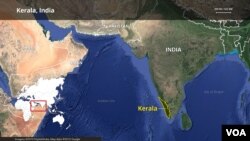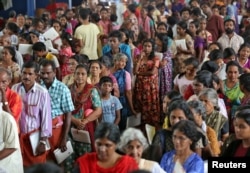As India’s southern Kerala state looks at the task of rebuilding in the aftermath of devastating floods that swept away homes, inundated farmland and destroyed infrastructure, environmentalists have raised the question: Could the damage have been reduced if more attention had been paid to sustainable development?
The floods were triggered by the most intense rains in nearly a century that lashed a picturesque state whose coastal plains and low-lying mountains beckon tens of thousands of tourists each year. Gates of overflowing dams had to be opened following heavy downpours starting August 8, sending water rushing across much of the state.
Environmental experts say a construction boom that saw houses, buildings and tourist resorts mushroom in areas that traditionally soaked up rainwater worsened the impact of the monsoon.
“There is a huge wave of construction, firstly on wetlands, which would have otherwise earlier stored water, no longer do so and encroachments on rivers,” said ecologist Madhav Gadgil, who in 2011 prepared a report for the Ministry of Environment, Forest and Climate Change on protecting the highlands known as Western Ghats.
Natural resources
Gadgil said the massive construction prompted indiscriminate sand mining and quarrying in the mountains.
“Large number of landslides have occurred because of these stone quarries. Rubble from them has blocked streams and rivers,” he said. Some of the 400 victims of the recent flooding included people buried under landslides.
The rapid development in Kerala in recent decades was partly fueled by money from tourists as well as from a diaspora from the state that lives and works in Middle East countries.
G.M. Pillai, the head of the World Institute of Sustainable Energy in Pune, claims the recent flooding was more devastating because of the disappearance of traditional paddy fields.
“About 80 percent of the paddy fields in Kerala have been leveled or converted to other activities, either construction or rubber plantations. That is a huge environmental neglect,” he said. “Paddy fields are kind of wetlands in Kerala’s topography capturing water from the surrounding hills.”
Pillai, who grew up in a village in Kerala, said traditional drains have been blocked there, too.
He said the international airport, in the state’s main city, Kochi, was built close to the Periyar River and had to be closed after runways were damaged and floodwaters entered the airport. It is scheduled to reopen later this month.
Environmental degradation
This is not the first time that experts have drawn attention to environmental degradation as India caters to the ever-growing needs for more power, roads and homes for its 1.3 billion people. After heavy rains in 2013 triggered devastating floods and landslides in the northern state of Uttarakhand, an environmental panel said the buildup of sediment in rivers, caused by hydroelectric plants, had aggravated the flooding.
In 2014, as floods swept Kashmir, encroachments were blamed for diminishing the holding capacity of lakes and other water bodies, aggravating the impact of the heavy rains.
But others point out that the push for development cannot be ignored, Kerala, for example, has one of the highest population densities in the country, putting pressure on the land.
“A lot of people from the villages are coming to cities for work. So, naturally, development is necessary,” said John Samuel of the Institute for Sustainable Development and Governance in Thiruvananthapuram, Kerala’s capital.
But Samuel calls for a halt to construction along riverbanks and strict observance of environmental laws.
“They have lots of houses coming, flats coming on the banks of the river. That can cause more havoc,” he said.
Some senior officials in the state have said that Kerala will have to seek sustainable development as it rebuilds damaged homes and thousands of kilometers of eroded roadways. But others worry that the mammoth task of reconstruction will only put more pressure on resources.
“The immediate requirement is constructing infrastructure which has been lost,” Pillai said. “But along with that you should also do what I call construction of environmental infrastructure, you have to restore a lot of those paddy fields, for example, which have been lost.”














